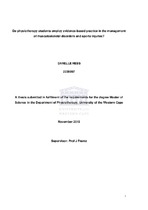| dc.description.abstract | Background: Musculoskeletal disorders (MSD’s) and sports injuries are commonly
sustained throughout the world daily. They are dominant in many countries, with
considerable cost involvement and impact on quality of life. For this reason they need to be recognised as a necessary part of general practice. MSD’s refer to a wide variety of diseases and disorders of the musculoskeletal system, such as
degenerative and inflammatory conditions (arthritis), spinal and soft tissue disorders, osteoporosis and musculoskeletal injury. Managing these musculoskeletal conditions are a challenge and using the best available evidence should be the first the choice. All health professionals should have the ability to determine the best available evidence and thus strive to give their patients the best health care known to them. Evidence-based practice (EBP) is an important key in making this happen as it uses the best current evidence in the decision-making process regarding the care of patients. Literature highlights that health care professionals are expected to implement evidence-based practice (EBP); this means that newly graduated students and health care professionals alike are required to be confident in exercising this skill of EBP. When expecting EBP from students, educators need to realize that students have limited clinical experience. Therefore, they need the skills to acquire the best research evidence when applying the best treatment for patients. In introducing evidence-based practice, various research is aimed at evaluating the health professional’s attitude and behaviour towards evidence-based practice (EBP). There is limited research regarding the actual implementation of EBP in everyday practice. Aim: Therefore, the aim of the study was to determine if undergraduate physiotherapy students implement evidence-based practice in the management of musculoskeletal disorders and sports injuries. Objectives: The study had four objectives: i) To determine the most common treatment techniques used by students in the management of the conditions treated at the UWC clinic through data extraction
of patient records in the clinic using a self-designed data extraction sheet, ii) To
determine the knowledge and beliefs about EBP among undergraduate physiotherapy students through a survey, iii) To determine an evidence-based intervention strategy of one of the most common conditions seen through a systematic review and iv) To map the links between current practice, student beliefs and evidence-based information. vii Methodology: The study used a predominantly quantitative approach with a few open ended questions and took place at a student training Physiotherapy clinic. The first phase was a retrospective document analysis study which consisted of data extraction of patient records for the period January 2009 to December 2011. The second phase used a mixed methods approached and consisted of a questionnaire with both closed and open-ended questions. It was completed by the 2012 registered fourth year students regarding attitudes and knowledge of EBP. The third phase consisted of a systematic review to identify the evidence for interventions used to manage one of the most common conditions identified. In the final phase and discussion of this thesis triangulation of the data was used by the researcher in order to formulate a picture of whether students apply evidence-based practice by using the data extracted from the patient folders in combination with the questionnaire survey of
the participants and the systematic review. Data analysis for phases one and two was done using SPSS Statistical package software to determine frequencies and
descriptive statistics. Phase two also had two open ended questions and this was
analysed thematically and data was coded, themes allocated and responses counted. The systematic review focused on systematic reviews of treatments for low back pain and this was narratively described. The research project received ethical clearance from the University of the Western Cape Research Grants and Study Leave Committee (project registration number: 12/3/12), and permission to conduct the survey was obtained from the Head of Department. Informed consent was obtained from all participants, they were informed of the research process at the outset of the project, and kept up-to-date at every major stage. Questionnaires for surveys were accompanied by an information sheet explaining the background and reason for conducting the survey, and students gave written, informed consent following an opportunity to clarify the study details. Results: The results showed that males were predominantly seen at the physiotherapy clinic, and that the most common complaint was pain in the neck, shoulder and lower back area. The students most common treatment choice was soft tissue mobilisation and the use of heat for all three these areas of pain. The questionnaire responses were also captured using SPSS and frequencies and descriptive statistics employed. These results showed that although students knew what EBP was it was not clear that they knew how to implement it. The systematic review assessed and established the most common treatments used in literature for the treatment of lower back pain; and pain, function and disability were viii the only outcomes considered. The only intervention that had a positive effect on the included outcomes was the use of manual therapy (spinal manipulation and mobilisation). In triangulating the data, it was shown that the students do not seem to use the same treatment choices as the literature indicates. Conclusion: The results show that there is very little link between the students choices of treatment for one of the common conditions highlighted and the current literature. It is therefore possible that although students understand the term EBP they do not show that they know how to use or implement the concept. Implications for practice: Institutions may need to be more vigilant about making provision for EBP in the curriculum as well as how it is implemented so that students can be comfortable with this practice. More
randomised controlled trials and systematic reviews are necessary on physiotherapy interventions so that practice can be better informed. Finally, EBP is perhaps one way to promote a culture of life-long learning within the physiotherapy profession. | en_US |

